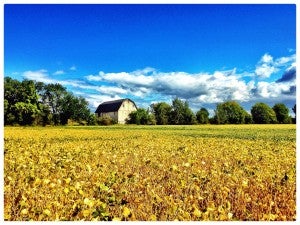
Suzy Friedman, Director of Agricultural Sustainability at EDF
I’ve been working to promote and implement sustainable agriculture practices for nearly 15 years. But the last two years have seen more action and momentum in this space than in all of the previous 13 years combined – and I’m more enthusiastic than ever.
Let me be clear – we still have a long way to go. As a USDA report released at the Paris climate talks noted, warming temperatures pose a significant threat to agriculture and food security across the globe. And, despite technological advancements, the multimillion-dollar question of how we’re going to measure and quantify sustainable agriculture remains.
But a new progress report from the White House Council on Environmental Quality (CEQ), also released last week in Paris, reaffirms my optimism and excitement. We’re headed in the right direction, and sustainable agriculture is on its way to becoming the norm. Here’s why.
Climate change tipping point
The CEQ report highlighted USDA’s ambitious plan to reduce emissions from agriculture. The agency launched 10 Building Blocks for Climate Smart Agriculture & Forestry to support efforts by farmers, ranchers, and forest landowners to mitigate and adapt to climate change. Priorities within the plan include improving soil health, nutrient management, livestock management, conservation of sensitive lands, and stewardship of private and public forests.
According to USDA, these building blocks will reduce net emissions by about 120 million metric tons per year by 2025. That’s the same as taking 25 million cars off of the road – every year for the next 10 years.
The CEQ report also emphasized the potential for collaboration between the private sector and the food supply chain. These partnerships are taking place every day. EDF, for example, is helping Walmart, Smithfield Foods, General Mills, Unilever, and Campbell’s Soup with their sustainable sourcing efforts.
These landmark efforts are getting us closer to a tipping point for sustainable agriculture. Adoption of farming practices that reduce emissions from agriculture and make crops more resilient to extreme weather events is widespread – and growing.

Credit: Flickr user Lawrence Lazare
Quantifying sustainability
We need a solid data collection and measurement system to ensure that all of these efficiency and soil health practices are generating the needed environmental and economic results. We’ll also need an integrated system that can connect farm data with corporate sustainability metrics so that farmers can understand their footprint and make business-smart decisions on how to improve, and companies can understand as well as influence their footprint across sourcing regions.
The White House report included encouraging news on this front – federal agencies are ramping up efforts to integrate massive farm data sets and improve documentation and data collection for measuring environmental changes across farmland. This is a huge step in the right direction.
Private sector collaborations like Field to Market are also bringing supply chain players together to develop a common set of metrics for sustainability.
This momentum, coupled with the boom in agricultural data collection made possible by advances in precision agriculture, will give us the knowledge needed to apply the best solutions, to reduce emissions, and protect our food supply, farmers, and the planet.
Related content
New climate change report is an urgent call to action for agriculture









